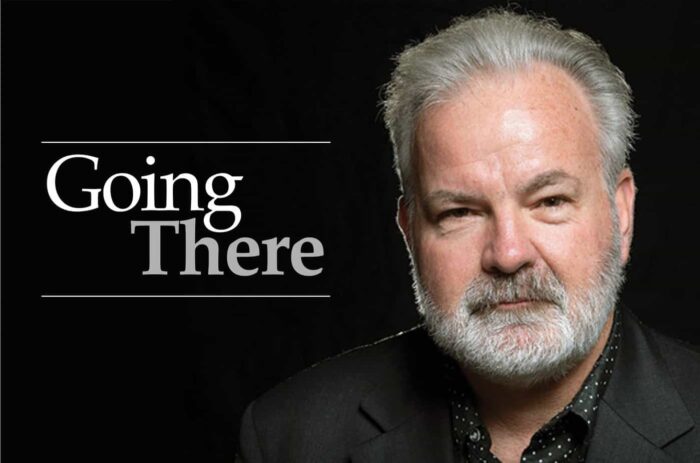You’re up, kids. We’re sorry.

by Mick Rhodes | editor@claremont-courier.com
Growing up in Glendora, the San Gabriel Mountains were a constant looming presence. We lived at their base, on north Live Oak Avenue, and though I took them for granted, they nonetheless served as my ever-present northern compass.
But not always. In the summertime they would disappear behind a thick blanket of smog.
In the early 1970s I spent a large chunk of my summers playing baseball at my nearby elementary school. We’d return home in the afternoon when the smog caused our chests to ache. We called it being “smogged out.” It was just part of the routine. There were “smog days” at school, where we didn’t play outside. Little League games were sometimes cancelled due to excessive airborne sludge.
The earliest mentions of what would later be called smog were recorded in Downtown Los Angeles the summer of 1943. People assumed the eye-stinging haze was a “gas attack,” and blamed a nearby butadiene plant. But after the plant was shuttered, the smog persisted. The Los Angeles County Air Pollution Control District — the first of its kind in the country — was formed in 1947. It began regulating oil refineries and power plants, but the smog just got worse.
Dutch chemist and CalTech professor Arie Haagen-Smit was the first to make the clear scientific connection to auto emissions in the early 1950s, paving the way for the establishment in 1967 of the California Air Resources Board. In 1970 the federal government enacted the Clean Air Act, which, with amendments in 1977 and 1990, created nationwide air quality monitoring, emission control, and enforcement statutes, and gave California the freedom to enact its own more aggressive standards which exceeded nationwide requirements.
Though smog remains and LA still consistently tops the list for worst air quality in the nation, the region has seendramatic improvements since California began leading the way in the 1970s, to the point where being “smogged out” is a thing of the past in my old neighborhood.
The pathway to cleaner air began when politicians of all stripes looked out their windows, saw the evidence, and followed the science.
In 1970 this was just common sense.
In 2023, not so much.

Students and activists from cities across the world called for climate change action during a protest ahead of the 2019 UN Climate Action Summit in New York City. Photo/by Markus Spiske
“There has been a steady decline in confidence in medical scientists among Republicans and Republican leaners since April 2020,” according to a 2022 Pew Research Center study. “In the latest survey, just 15% have a great deal of confidence in medical scientists, down from 31% who said this in April 2020 and 26% who said this in November 2020.”
Another telling statistic from the study is that education is a reliable indicator of how much trust one places in medical science. It found just 12% of Republicans with some college or less, and 21% with college degrees, had “a great deal” of confidence in medical science. Thirty-eight percent of Democrats with some college or less had a great deal of confidence, and 54% of the party’s college graduates trusted the science.
The divide among party lines regarding climate change is also stark. (I realize “medical science” and “climate science” are two different disciplines, but the concept of scientific distrust is applicable to both.) That same Pew study shows just 23% of Republicans view climate change as a major threat, compared to 78% of Democrats. That’s a big gap.
The good news is younger Americans are far more open to completely phasing out fossil fuels — by far the leading contributing factor to climate change — across both political parties. A full 58% of Democrats between the ages of 18 and 29 support relying exclusively on renewable energy, and a promising 29% of like-aged Republicans agree. Those numbers may sound low, but considering just 3% of Republicans aged 65 or older felt the same way as their younger party members, it’s remarkable. (42% of Democrats over 65 said they would like to see fossil fuels phased out entirely).
Last week’s debate with Republican presidential hopefuls brought this trust gap into glaring focus when moderators Bret Baier and Martha MacCallum asked the eight candidates for a show of hands for those who believed humans had caused climate change, and former tech and finance executive Vivek Ramaswamy declared, “The climate change agenda is a hoax.” The rest of the panel either ignored or sidestepped the question, with the exception of former South Carolina governor and UN ambassador under Donald Trump, Nikki Haley, who had the temerity to acknowledge its existence.
The timing of that confluence of populist politics overriding long settled science was particularly embarrassing coming on the heels of the deadly Lahaina wildfires that began August 8, and Hurricane Hilary, which made landfall in Southern California as a tropical storm on August 20 following the first tropical storm watch the National Weather Service had ever issued for the Golden State.
But perhaps there’s hope.
Thankfully, young people are smarter than us; they’re more accepting and more open to new ideas. I’m basing these hypotheses on my own experience as a father of four, and on purely un-scientific polling of my wildly biased friend group. And the Pew numbers seem to back me.
My generation sure dropped the ball and continues to do so, on this and several other fronts. The kids are going to have to stand up to the fossil fuel lobby and entrenched ideologues who stand in the way of meaningful climate action. It’s a lot to ask, but there it is. Nobody else, save a handful of truly progressive members of Congress, has the stomach for it.
Something clearly has to give. C’mon kids. You’re up.









0 Comments